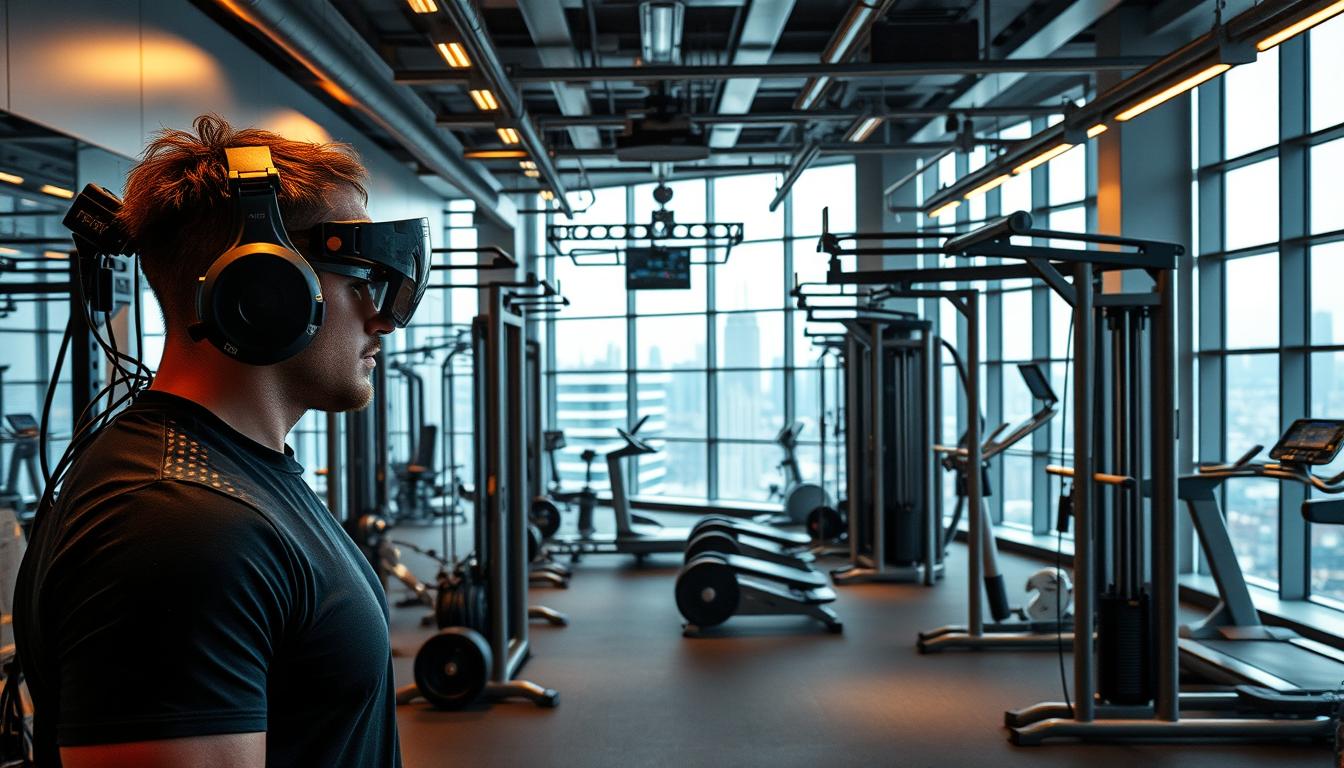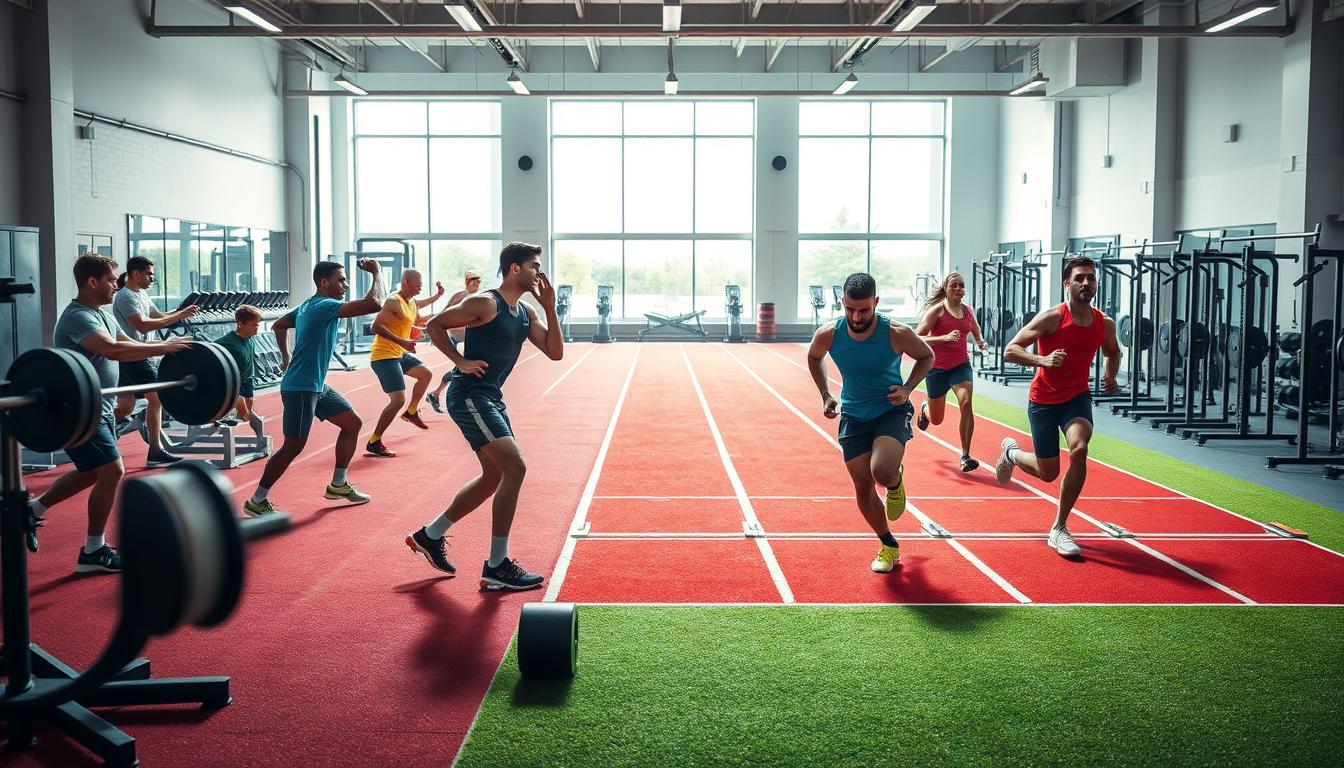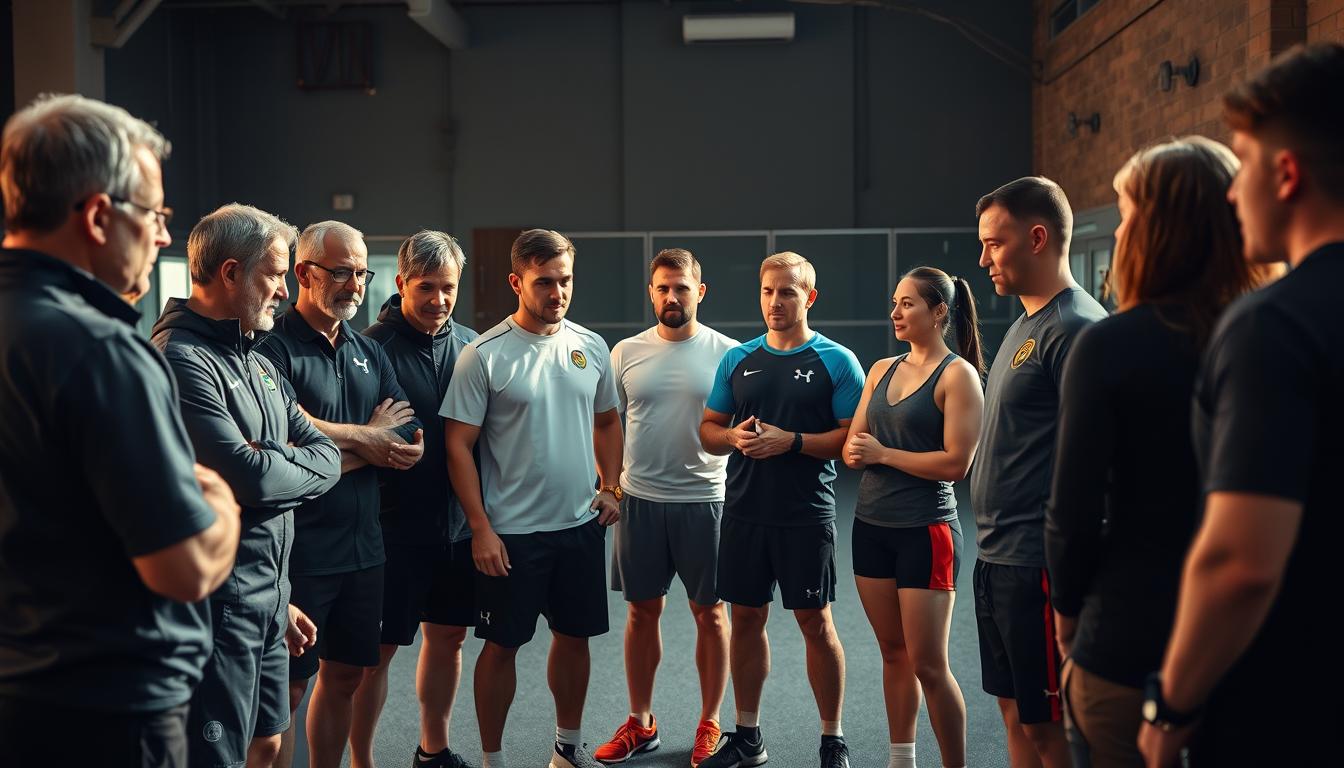As an athlete, I've faced the hurdles of striving for athletic performance excellence. Reaching your goals demands a comprehensive strategy. This includes training, nutrition, recovery, and mental preparation.
Grasping the science behind optimal athletic achievement and using proven methods can elevate your athletic potential. This guide will cover the key aspects to help you shine in your sport.
Key Takeaways
- Understand the importance of a holistic approach to athletic achievement.
- Learn how to optimize your training for maximum results.
- Discover the role of nutrition in enhancing athletic performance.
- Explore techniques for effective recovery and mental preparation.
- Apply proven strategies to unlock your full athletic potential.
The Science Behind Athletic Excellence
Athletic performance enhancement is deeply rooted in understanding how our bodies react to training. Exploring sports science reveals that achieving top performance goes beyond physical effort. It requires a profound grasp of human performance physiology.
Understanding Human Performance Physiology
Human performance physiology studies how our bodies operate during exercise. It involves factors like cardiovascular health, muscular strength, and endurance.
How Your Body Adapts to Training Stimuli
Regular training triggers several adaptations in our bodies. These include enhanced muscular strength, better cardiovascular efficiency, and improved neuromuscular coordination. For example, as I train, my muscles grow more mitochondria. This boosts energy production efficiency.
Energy Systems and Athletic Performance
Three main energy systems power athletic performance: phosphagen, glycolytic, and oxidative phosphorylation. Knowing how these systems impact my performance allows me to fine-tune my training. Sprinters, for instance, rely on the phosphagen system, while distance runners use oxidative phosphorylation.
The Role of Sports Science in Modern Athletics
Sports science is crucial in modern athletics, offering training methods backed by research. By applying scientific principles, athletes can optimize their training for superior performance.
Research-Backed Approaches to Training
Research in sports science has developed evidence-based training methods. These include periodization, which varies training intensity and volume to prevent plateaus and overtraining. A well-designed training program, informed by current research, is essential for achieving athletic excellence.
| Training Method | Description | Benefits |
| Periodization | Varying training intensity and volume | Avoids plateaus, prevents overtraining |
| High-Intensity Interval Training (HIIT) | Short bursts of high-intensity exercise | Improves cardiovascular health, increases speed and endurance |
| Strength Training | Resistance exercises to build muscle | Enhances muscular strength, improves bone density |
Sports Performance: Unlocking Your Athletic Potential
Enhancing athletic performance requires a detailed process starting with identifying one's strengths and weaknesses. Athletes must undergo a thorough evaluation of their current capabilities to enhance sports performance.
Identifying Your Athletic Strengths and Weaknesses
The initial step in improving athletic abilities is to conduct a comprehensive assessment of your strengths and weaknesses. This process involves utilizing various performance assessment tools and methods.
Performance Assessment Tools and Methods
Several tools and methods are available to assess athletic performance, including:
- Physical fitness tests
- Video analysis software
- Heart rate monitoring
These tools aid athletes and coaches in pinpointing areas needing improvement.
Setting Realistic Yet Challenging Goals
After identifying strengths and weaknesses, athletes should set realistic yet challenging goals. The SMART goal framework is highly effective for this purpose.
SMART Goal Framework for Athletes
The SMART goal framework involves setting goals that are:
- Specific
- Measurable
- Achievable
- Relevant
- Time-bound
This structured method ensures athletes remain focused on their objectives.
Creating Your Performance Development Roadmap
With clear goals established, athletes can then create a performance development roadmap. This roadmap outlines the necessary steps to achieve the set goals and enhance sports performance over time.
By adhering to this structured approach, athletes can systematically enhance their athletic abilities and reach their full potential.
Nutrition Strategies for Peak Performance
Nutrition is key to boosting athletic performance and gaining a competitive edge. Athletes aiming to reach their peak must grasp the nuances of nutrition.
Macronutrient Balance for Different Sports
Different sports demand unique macronutrient ratios for peak performance. Endurance athletes, for example, require more carbohydrates to maintain energy over long periods.
Endurance vs. Power Athletes' Nutritional Needs
Endurance athletes, like marathon runners, focus on complex carbs and lean proteins. These support energy and muscle repair. Power athletes, such as sprinters, need more protein for muscle growth and strength.
| Athlete Type | Primary Macronutrient | Nutritional Focus |
| Endurance Athlete | Carbohydrates | Complex carbs, lean proteins |
| Power Athlete | Protein | High protein intake, balanced carbs |
Timing Your Nutrition for Training and Competition
Timing nutrition is crucial for peak performance. Athletes need to plan their pre, during, and post-workout meals to optimize their potential.
Pre, During, and Post-Workout Nutrition
Before workouts, a balanced meal with carbs and protein is essential. During long activities, sports drinks or energy gels keep energy levels up. After, a mix of carbs and protein aids in recovery and muscle repair.
Hydration Protocols for Optimal Performance
Proper hydration is essential for athletes to perform at their best. Dehydration can decrease performance and increase injury risk.
Electrolyte Balance and Performance Impact
Electrolyte balance is critical, especially during intense or long activities. Electrolytes like sodium and potassium regulate fluid balance and support muscle function. Drinking electrolyte-rich beverages or taking supplements can prevent imbalances.
By understanding and applying these nutrition strategies, athletes can significantly boost their performance and meet their competitive goals.
Training Methodologies That Deliver Results
To achieve athletic excellence, it's crucial to implement effective training methodologies that drive results. A well-structured training program is the foundation upon which athletes can increase sports performance and reach their full potential.
Periodization: Structuring Your Training Calendar
Periodization involves dividing the training calendar into specific periods or phases, each with a particular focus. This approach allows athletes to peak at the right time and avoid overtraining.
Linear vs. Undulating Periodization Models
Linear periodization progresses in a straightforward manner, with intensity or volume increasing over time. Undulating periodization, on the other hand, involves more frequent changes in training intensity or volume. This varied stimulus can be beneficial for some athletes.
Sport-Specific vs. Cross-Training Approaches
Athletes often debate whether to focus on sport-specific training or incorporate cross-training into their regimen. Sport-specific training directly improves performance in the athlete's primary sport. Cross-training, however, can enhance overall fitness and reduce the risk of overuse injuries.
Building Transferable Athletic Skills
Cross-training can help build skills that are transferable across different sports, enhancing overall athleticism. This can be particularly beneficial for athletes looking to diversify their training and improve resilience.
Recovery-Based Training Models
Recovery is a critical component of any training program. Recovery-based training models prioritize adequate rest and recovery techniques. This ensures that athletes can train at high intensities without succumbing to overtraining.
Balancing Intensity and Volume
One of the key challenges in designing a training program is balancing intensity and volume. Too much intensity can lead to burnout, while too much volume can result in overtraining. Finding the right balance is crucial for optimizing performance and achieving long-term success.
By understanding and implementing these training methodologies, athletes can tailor their training to meet their specific needs. This ultimately leads to improved performance and the achievement of their athletic goals.
Mental Conditioning for Athletic Success
To enhance athletic performance, one must concentrate on the mental aspects of their sport. Mental conditioning is essential for achieving top athletic levels. It allows athletes to perform well under pressure and overcome challenges.
Developing Mental Toughness and Resilience
Mental toughness is about enduring pressure and recovering from setbacks. This quality can be developed through consistent practice and training. Mindfulness practices are an effective way to build mental resilience.
Mindfulness Practices for Athletes
Mindfulness is about being fully present in the moment. For athletes, it can improve focus, reduce stress, and enhance performance. Techniques include meditation, deep breathing, and mindful movement.
Visualization and Performance Psychology
Visualization is a key tool for athletes to prepare for competitions. It involves mentally rehearsing a performance and imagining success. This technique boosts confidence and prepares athletes for various scenarios.
Creating Effective Mental Rehearsal Routines
To develop an effective mental rehearsal routine, athletes should first identify their goals. Then, they should visualize themselves achieving those goals. They should also imagine the steps to success, including overcoming obstacles. Regular practice reinforces positive outcomes and builds resilience.
Managing Competition Anxiety and Pressure
Competition anxiety is a common issue athletes face. Managing this anxiety is vital for peak performance. Techniques like pre-competition mental preparation help athletes stay focused and composed.
Pre-Competition Mental Preparation Techniques
Pre-competition mental preparation involves strategies to manage anxiety and stay focused. This includes visualization, positive self-talk, and relaxation techniques. By mentally preparing before a competition, athletes can improve their performance and reach their goals.
Recovery Techniques to Enhance Performance
For athletes aiming to maximize their potential, recovery is as vital as training. Implementing effective recovery techniques is crucial for boosting sports performance training and enhancing athletic performance.
Sleep Optimization for Athletes
Athletes must prioritize sleep optimization to ensure proper recovery. Sleep is when the body repairs and adapts, making it essential for athletic performance.
Sleep Cycles and Performance Correlation
Studies have established a direct link between sleep cycles and athletic performance. Athletes who sleep well tend to perform better and react faster.
Active vs. Passive Recovery Methods
Athletes have the option between active recovery methods, like light cardio and stretching, and passive recovery methods, such as rest and ice baths. Knowing when to apply each is critical.
When to Use Different Recovery Approaches
The choice between active and passive recovery hinges on training intensity and athlete condition. A mix of both often leads to optimal results.
Injury Prevention and Management
Injury prevention is vital for enhancing athletic performance. Prehabilitation exercises can help ward off common sports injuries.
Prehabilitation Exercises for Common Sports Injuries
Prehabilitation exercises, such as strengthening knee and ankle muscles, can significantly lower injury risk. Below is a table detailing some common prehabilitation exercises:
| Injury Type | Prehabilitation Exercise | Benefit |
| Knee Injuries | Squats, Lunges | Strengthens surrounding muscles |
| Ankle Injuries | Calf Raises, Ankle Circles | Improves ankle stability |
| Lower Back Injuries | Planks, Bridging | Strengthens core muscles |
By integrating these recovery techniques into their training, athletes can improve their sports performance training and achieve superior athletic performance enhancement.
Technology and Tools for Performance Tracking
Technology has become essential for achieving athletic greatness. The right tools offer insights into performance, helping athletes improve their athletic abilities.
Wearable Tech for Athletic Monitoring
Wearable technology tracks physiological metrics like heart rate variability. This data helps athletes optimize their training and avoid injuries.
Interpreting Heart Rate Variability and Other Metrics
Heart rate variability shows an athlete's readiness to train. By analyzing this, athletes can adjust their training intensity and volume.
Data Analysis for Performance Improvement
Data analysis is key to making training adjustments based on metrics. Athletes can refine their training and see better results by using data.
Turning Numbers into Actionable Training Adjustments
Effective data analysis uncovers trends and patterns. This information guides training decisions, helping athletes improve their performance.
Virtual Coaching and Training Platforms
Virtual coaching and training platforms offer remote access to quality coaching. They provide tools and resources to help athletes achieve their goals.
Maximizing Remote Training Resources
Virtual platforms enable athletes to maximize their training remotely. They stay on track, even without in-person coaching.
Building Your Support Team
Creating a robust support team is essential for athletes aiming to reach their full potential. A diverse team offers the necessary guidance, care, and motivation. This support is crucial for athletes to achieve their goals.
Working With Coaches and Trainers
Coaches and trainers are key to improving sports performance. They craft personalized training plans, offer technical guidance, and provide feedback. These elements are vital for athletes to enhance their skills.
Finding the Right Coaching Match for Your Goals
To maximize your coaching benefits, it's vital to find a coach who aligns with your goals and needs. Evaluate their experience, coaching style, and how well they match your athletic objectives.
The Role of Sports Medicine Professionals
Sports medicine professionals are indispensable for maintaining peak physical condition. They address health issues that may arise during training or competition.
When to Consult Specialists for Performance Enhancement
It's crucial to know when to seek advice from specialists like physical therapists, nutritionists, or sports psychologists. Consult them for personalized advice on injury prevention, nutrition, or mental preparation.
Creating a Performance-Focused Environment
Surrounding yourself with positive influences is vital for maintaining motivation and focus. This includes your coaching and medical team, as well as family, friends, and fellow athletes who support your goals.
Surrounding Yourself with Positive Influences
Positive influences can take many forms, from supportive family members to like-minded athletes. Cultivate these relationships to build a network that encourages and motivates you to perform at your best.
- Identify professionals who can help you achieve your athletic goals.
- Ensure your coaching team is aligned with your specific needs and objectives.
- Leverage sports medicine professionals to maintain peak physical condition.
By assembling a comprehensive support team, you can enhance your sports performance. This will help you move closer to achieving your athletic aspirations.
Overcoming Performance Plateaus
Breaking through a athletic performance optimization plateau demands a comprehensive strategy. It must tackle both physical and mental hurdles. Athletes often hit a wall, unable to enhance their performance despite relentless training.
Identifying the Causes of Stagnation
Understanding the root of stagnation is the initial step to overcome it. This barrier can stem from physical or psychological factors.
Physical vs. Psychological Barriers
Physical barriers might include insufficient training, poor nutrition, or inadequate recovery. Psychological barriers, however, encompass mental fortitude, motivation, and stress management.
| Barrier Type | Causes | Solutions |
| Physical | Inadequate training, poor nutrition | Adjust training regimen, improve nutrition |
| Psychological | Lack of motivation, high stress | Visualization techniques, stress management |
Breakthrough Strategies and Techniques
To increase sports performance, athletes can use several strategies. Varying training and applying progressive overload are key methods to push athletes beyond their limits.
Training Variation and Progressive Overload
Shifting the training routine can prevent boredom and stimulate growth. Progressive overload involves incrementally increasing workout intensity.
"The greatest glory in living lies not in never falling, but in rising every time we fall." - Nelson Mandela
Case Studies: Athletes Who Conquered Their Plateaus
Studying athletes who have successfully navigated plateaus offers crucial insights. Their experiences underscore the value of persistence and strategic planning.
Lessons from Elite Performers' Comebacks
Elite athletes often exhibit common traits in their comebacks. These include a robust support network and a readiness to adjust their training.
Conclusion: Your Path to Athletic Excellence
Achieving athletic excellence demands dedication, the right strategies, and a supportive network. By applying the principles from this article, you can reach your full potential. This maximizes your sports performance.
Understanding the science behind athletic excellence is key. It's also vital to know your strengths and weaknesses. Developing a tailored training plan is crucial. Nutrition, mental conditioning, and recovery techniques also significantly impact your performance.
By integrating these elements and staying committed, you can overcome performance plateaus. This leads to success in your athletic endeavors. With the right mindset and approach, you can unlock your full potential. You will reach new heights in your sports performance journey.





Comments
Post a Comment